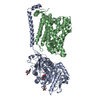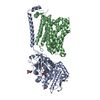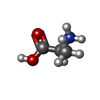+ Open data
Open data
- Basic information
Basic information
| Entry | Database: PDB / ID: 8wnt | ||||||
|---|---|---|---|---|---|---|---|
| Title | Cryo EM map of SLC7A10 with L-Alanine substrate | ||||||
 Components Components |
| ||||||
 Keywords Keywords |  MEMBRANE PROTEIN / SLC7A10 / ASC-1 MEMBRANE PROTEIN / SLC7A10 / ASC-1 | ||||||
| Function / homology |  Function and homology information Function and homology informationD-alanine transmembrane transport / D-serine transmembrane transport / positive regulation of synaptic transmission, glycinergic / glycine transport / L-serine transmembrane transporter activity / neutral L-amino acid secondary active transmembrane transporter activity / Defective SLC7A7 causes lysinuric protein intolerance (LPI) / methionine transport / tyrosine transport / L-histidine transport ...D-alanine transmembrane transport / D-serine transmembrane transport / positive regulation of synaptic transmission, glycinergic / glycine transport / L-serine transmembrane transporter activity / neutral L-amino acid secondary active transmembrane transporter activity / Defective SLC7A7 causes lysinuric protein intolerance (LPI) / methionine transport / tyrosine transport / L-histidine transport / apical pole of neuron / aromatic amino acid transmembrane transporter activity / amino acid transport complex / L-amino acid transmembrane transporter activity / : / L-leucine import across plasma membrane / L-alanine transmembrane transporter activity / isoleucine transport / L-alanine import across plasma membrane / phenylalanine transport / valine transport / negative regulation of brown fat cell differentiation / L-leucine transmembrane transporter activity / proline transport / amino acid transmembrane transport / calcium:sodium antiporter activity / L-leucine transport / thyroid hormone transport / neutral amino acid transport / Amino acid transport across the plasma membrane / neutral L-amino acid transmembrane transporter activity / Tryptophan catabolism /  exogenous protein binding / amino acid transport / anchoring junction / Basigin interactions / response to exogenous dsRNA / tryptophan transport / basal plasma membrane / calcium ion transport / exogenous protein binding / amino acid transport / anchoring junction / Basigin interactions / response to exogenous dsRNA / tryptophan transport / basal plasma membrane / calcium ion transport /  double-stranded RNA binding / double-stranded RNA binding /  melanosome / virus receptor activity / basolateral plasma membrane / carbohydrate metabolic process / melanosome / virus receptor activity / basolateral plasma membrane / carbohydrate metabolic process /  cadherin binding / symbiont entry into host cell / apical plasma membrane / protein heterodimerization activity / lysosomal membrane / cadherin binding / symbiont entry into host cell / apical plasma membrane / protein heterodimerization activity / lysosomal membrane /  synapse / synapse /  cell surface / protein homodimerization activity / cell surface / protein homodimerization activity /  RNA binding / extracellular exosome / RNA binding / extracellular exosome /  nucleoplasm / nucleoplasm /  membrane / membrane /  plasma membrane plasma membraneSimilarity search - Function | ||||||
| Biological species |   Homo sapiens (human) Homo sapiens (human) | ||||||
| Method |  ELECTRON MICROSCOPY / ELECTRON MICROSCOPY /  single particle reconstruction / single particle reconstruction /  cryo EM / Resolution: 3.42 Å cryo EM / Resolution: 3.42 Å | ||||||
 Authors Authors | Li, Y.N. / Guo, Y.Y. / Dai, L. / Yan, R.H. | ||||||
| Funding support | 1items
| ||||||
 Citation Citation |  Journal: Nat Commun / Year: 2024 Journal: Nat Commun / Year: 2024Title: Cryo-EM structure of the human Asc-1 transporter complex. Authors: Yaning Li / Yingying Guo / Angelika Bröer / Lu Dai / Stefan Brӧer / Renhong Yan /   Abstract: The Alanine-Serine-Cysteine transporter 1 (Asc-1 or SLC7A10) forms a crucial heterodimeric transporter complex with 4F2hc (SLC3A2) through a covalent disulfide bridge. This complex enables the sodium- ...The Alanine-Serine-Cysteine transporter 1 (Asc-1 or SLC7A10) forms a crucial heterodimeric transporter complex with 4F2hc (SLC3A2) through a covalent disulfide bridge. This complex enables the sodium-independent transport of small neutral amino acids, including L-Alanine (L-Ala), Glycine (Gly), and D-Serine (D-Ser), within the central nervous system (CNS). D-Ser and Gly are two key endogenous glutamate co-agonists that activate N-methyl-d-aspartate (NMDA) receptors by binding to the allosteric site. Mice deficient in Asc-1 display severe symptoms such as tremors, ataxia, and seizures, leading to early postnatal death. Despite its physiological importance, the functional mechanism of the Asc-1-4F2hc complex has remained elusive. Here, we present cryo-electron microscopy (cryo-EM) structures of the human Asc-1-4F2hc complex in its apo state, D-Ser bound state, and L-Ala bound state, resolved at 3.6 Å, 3.5 Å, and 3.4 Å, respectively. Through detailed structural analysis and transport assays, we uncover a comprehensive alternating access mechanism that underlies conformational changes in the complex. In summary, our findings reveal the architecture of the Asc-1 and 4F2hc complex and provide valuable insights into substrate recognition and the functional cycle of this essential transporter complex. | ||||||
| History |
|
- Structure visualization
Structure visualization
| Structure viewer | Molecule:  Molmil Molmil Jmol/JSmol Jmol/JSmol |
|---|
- Downloads & links
Downloads & links
- Download
Download
| PDBx/mmCIF format |  8wnt.cif.gz 8wnt.cif.gz | 178 KB | Display |  PDBx/mmCIF format PDBx/mmCIF format |
|---|---|---|---|---|
| PDB format |  pdb8wnt.ent.gz pdb8wnt.ent.gz | 135.2 KB | Display |  PDB format PDB format |
| PDBx/mmJSON format |  8wnt.json.gz 8wnt.json.gz | Tree view |  PDBx/mmJSON format PDBx/mmJSON format | |
| Others |  Other downloads Other downloads |
-Validation report
| Arichive directory |  https://data.pdbj.org/pub/pdb/validation_reports/wn/8wnt https://data.pdbj.org/pub/pdb/validation_reports/wn/8wnt ftp://data.pdbj.org/pub/pdb/validation_reports/wn/8wnt ftp://data.pdbj.org/pub/pdb/validation_reports/wn/8wnt | HTTPS FTP |
|---|
-Related structure data
| Related structure data |  37672MC  8wnsC  8wnyC M: map data used to model this data C: citing same article ( |
|---|---|
| Similar structure data | Similarity search - Function & homology  F&H Search F&H Search |
- Links
Links
- Assembly
Assembly
| Deposited unit | 
|
|---|---|
| 1 |
|
- Components
Components
| #1: Protein | Mass: 68164.680 Da / Num. of mol.: 1 Source method: isolated from a genetically manipulated source Source: (gene. exp.)   Homo sapiens (human) / Gene: SLC3A2, MDU1 / Production host: Homo sapiens (human) / Gene: SLC3A2, MDU1 / Production host:   Homo sapiens (human) / References: UniProt: P08195 Homo sapiens (human) / References: UniProt: P08195 | ||||
|---|---|---|---|---|---|
| #2: Protein | Mass: 56837.504 Da / Num. of mol.: 1 Source method: isolated from a genetically manipulated source Source: (gene. exp.)   Homo sapiens (human) / Gene: SLC7A10, ASC1 / Production host: Homo sapiens (human) / Gene: SLC7A10, ASC1 / Production host:   Homo sapiens (human) / References: UniProt: Q9NS82 Homo sapiens (human) / References: UniProt: Q9NS82 | ||||
| #3: Polysaccharide | 2-acetamido-2-deoxy-beta-D-glucopyranose-(1-4)-2-acetamido-2-deoxy-beta-D-glucopyranose / Mass: 424.401 Da / Num. of mol.: 1 / Mass: 424.401 Da / Num. of mol.: 1Source method: isolated from a genetically manipulated source | ||||
| #4: Sugar |  N-Acetylglucosamine N-Acetylglucosamine#5: Chemical | ChemComp-ALA / |  Alanine AlanineHas ligand of interest | Y | |
-Experimental details
-Experiment
| Experiment | Method:  ELECTRON MICROSCOPY ELECTRON MICROSCOPY |
|---|---|
| EM experiment | Aggregation state: PARTICLE / 3D reconstruction method:  single particle reconstruction single particle reconstruction |
- Sample preparation
Sample preparation
| Component | Name: 4F2hc-ASC-1 complex / Type: COMPLEX / Entity ID: #1-#2 / Source: MULTIPLE SOURCES |
|---|---|
| Source (natural) | Organism:   Homo sapiens (human) Homo sapiens (human) |
| Source (recombinant) | Organism:   Homo sapiens (human) Homo sapiens (human) |
| Buffer solution | pH: 7.5 |
| Specimen | Embedding applied: NO / Shadowing applied: NO / Staining applied : NO / Vitrification applied : NO / Vitrification applied : YES : YES |
Vitrification | Cryogen name: ETHANE |
- Electron microscopy imaging
Electron microscopy imaging
| Experimental equipment |  Model: Titan Krios / Image courtesy: FEI Company |
|---|---|
| Microscopy | Model: FEI TITAN KRIOS |
| Electron gun | Electron source : :  FIELD EMISSION GUN / Accelerating voltage: 300 kV / Illumination mode: FLOOD BEAM FIELD EMISSION GUN / Accelerating voltage: 300 kV / Illumination mode: FLOOD BEAM |
| Electron lens | Mode: BRIGHT FIELD Bright-field microscopy / Nominal defocus max: 1800 nm / Nominal defocus min: 1200 nm Bright-field microscopy / Nominal defocus max: 1800 nm / Nominal defocus min: 1200 nm |
| Image recording | Electron dose: 50 e/Å2 / Film or detector model: GATAN K3 (6k x 4k) |
- Processing
Processing
| EM software | Name: PHENIX / Version: 1.20.1_4487: / Category: model refinement | ||||||||||||||||||||||||
|---|---|---|---|---|---|---|---|---|---|---|---|---|---|---|---|---|---|---|---|---|---|---|---|---|---|
CTF correction | Type: NONE | ||||||||||||||||||||||||
3D reconstruction | Resolution: 3.42 Å / Resolution method: FSC 0.143 CUT-OFF / Num. of particles: 300000 / Symmetry type: POINT | ||||||||||||||||||||||||
| Refine LS restraints |
|
 Movie
Movie Controller
Controller





 PDBj
PDBj







